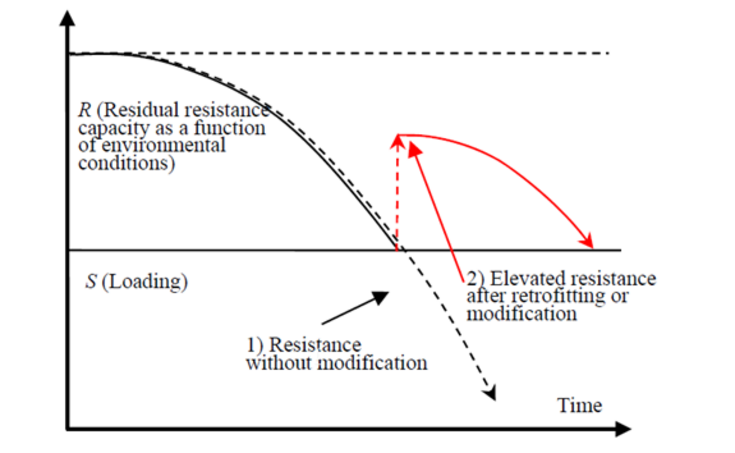In general, an initial model layout will not be able to capture the real behavior of structures or fastening systems due to aleatory and epistemic uncertainties and weak knowledge. These uncertainties can be reduced by engineering knowledge and their experience as well as by computationally expensive model updating procedures using observed model response. In addition, uncertainties can also be taken into account by model correction factors [166] according to EN1990 Appendix D “Basis of structural design - Design assisted by testing” [31].
It is obvious to assign so called ‘performance indicators’ to the most sensitive response quantities, thus providing the basis for the performance assessment of old systems, the continuous performance surveillance of existing systems, and system identification and optimization. These performance indicators are typically either directly monitored response quantities or derived values such as e.g. mean value correction factors.

Proposed solution and methodology
Fastening systems as connectors between structural elements are crucial for the behavior and performance of a whole structure. Conversely, this circumstance can be used to determine the performance of fastening elements based on globally observed structural response, if sufficiently smart monitoring concepts are applied. Various monitoring systems have already been used at the institute to analyze the health of concrete bridges. This infrastructure and knowledge will be transferred to post installed anchorages. The short term behavior will be the first field of research, followed by the long term displacement. The development of performance indicators will be performed in parallel to the mechanical characterization of fastenings in WP1 and the modeling of influencing environmental and load processes in WP2.
Mainly strain gauges, displacement- and acceleration-sensors will be used in order to analyze the impact and response of anchorage systems in real life. The results will also be used as validation for numerical simulations.
In the next step the recorded data and parameter provided by the monitoring system, which will be the inputs for performance indicators and the code based limit states, will be tested against random and systematic errors and the stability in time. The results and findings of this work package are a necessary fundamental knowledge for the assessment of fastening techniques.
Based on the numerical simulation and the destructive testing a comprehensive concept for the application of performance indicators will be developed. Using this concept, the key monitoring points for the different systems will be identified, e.g. based on sensitivity studies. By extensive parameter studies the decisive measuring parameters at the monitoring points regarding the system status and safety potential at the present time as well as the predicted lifecycle performance will be evaluated.
As a third step different non-destructive testing methods will be identified, used and further developed in order to evaluate the relevant parameters at the identified monitoring points of the post-installed anchoring systems. It is planned to use, e.g. ultra-sound and thermography. Other methods will be used when the results of the performed research require it.
This same framework allows the (inverse) identification of material properties and quantities describing degradation. In combination with material tests performed in WP1 and accelerated degradation tests conducted in WP2 a significantly improved understanding can be reached. Based on the mechanical model, the numerical and experimental destructive and nondestructive testing methods and the identified monitoring points, a comprehensive performance evaluation method for post-installed fastening systems will be developed. In this step the different developed models and testing as well as evaluation methods will be combined and completed in order to generate a realistic overall view and holistic model of the performance and behavior of post-installed anchoring systems under short term loading conditions.
